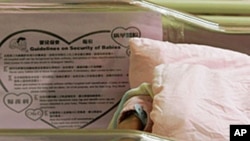New research finds that a procedure often used in childbirth to reduce the risk of potentially-fatal hemorrhage actually does little, if anything, to prevent bleeding.
But the study highlights the effectiveness of another way to safeguard the health of women giving birth.
Uncontrolled bleeding, or hemorrhage, is responsible for one-third of pregnancy-related deaths in Asia and Africa.
To reduce the risk of hemorrhage, the World Health Organization has recommended several procedures, including giving the mother a hormone called oxytocin, which helps the uterus contract and expel the placenta, and a technique called controlled-cord traction.
"You start pulling on the umbilical cord, and while pulling on that cord, you gently push the womb from the tummy upwards," explained Metin Gülmezoglu, MD, of the World Health Organization, who led the study of the effectiveness of controlled cord traction.
He says it’s a somewhat difficult procedure, "and if it's not applied by people who are skilled in doing it, then it may cause more problems."
Gülmezoglu's study, published online in The Lancet, included more than 23,000 pregnant women in eight countries. About half were given the so-called "full package" of birth procedures, which included controlled cord traction.
The other women got the "simplified package," where the birth was aided mainly by gravity and the mother pushing. Both groups got injections of oxytocin.
The study found that women in both groups had about the same average amount of blood loss, and that serious hemorrhage of more than a liter of blood was only very slightly less common in the group that got the controlled cord traction.
"The main factor that helps to reduce blood loss after birth is the oxytocin, the medication that helps the uterus to contract. And the procedure itself, in our study, adds a minute amount."
Oxytocin is given as an injection, but it's in the muscle so it's relatively uncomplicated and thus suitable for minimally trained birth attendants. It's not very costly, but the hormone can lose effectiveness if exposed to heat.
So new WHO guidelines may recommend single-use syringes that have a built-in sensor that warns when it has been subjected to high temperatures.





